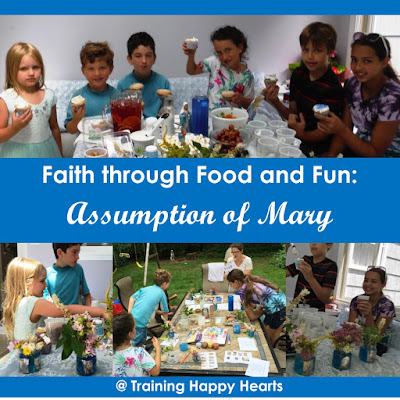August 23 is the optional Memorial of St. Rose of Lima, the first canonized saint of the Western Hemisphere and the saint whose name a local church bears. Thus, I plan to sprinkle our week with faith, food, and learning that relates to St. Rose of Lima.
As
I brainstorm some S.K.I.L.L. T.I.M.E + activities and a simple feast day meal, I
thought I'd share them in case you, too, would like to weave
saint-based learning, food, and fun into your week.
Saint Rose of Lima S.K.I.L.L. T.I.M.E + Ideas
{Disclosure: Some of the links which follow are affiliate ones.}
S - Spell and Learn Words
My daughter always cheers when we play our spelling word game, so, we'll likely write "Saint Rose of Lima" on mini-white boards and then try to create as many words as we can from the letters within the
saints' names within three minutes. Before
beginning our timer, we'll recall that every word has to have a vowel in
it and, then, suss out what vowels (and r-controlled vowels) we could use in our words, such as:
| /ă/ | a |
| /ā/ | a, ai, ea, ei |
| /ä/ | a |
| /ĕ/ | e, ea |
| /ē/ | e, ea, ei, i, ie |
| /ĭ/ | i |
| /ī/ | i, ei |
| /ŏ/ | o |
| /ō/ | o, oa, oe, oo |
| /ö/ | o, oo, oe |
| /ŭ/ | u, ou |
| /ū/ | u |
| /ü/ | u, oo |
| /oi/ | oi |
| /ow/ | ou |
Plus, the R-controlled vowels ER, IR, EAR, AR, and OR. |
|
We'll also look for consonant blends might help us form words (like fl, fr, sl, sm, sn, st, and str.) and, perhaps, recall some quick reminders of strategies:
- thinking
of rhyming words (i.e. "sat", "rat", and "slat")
- using
plural "s" or "es" and 3rd person singular verb "s" or "es" (such as
"lot", "lots", "tan" and "tans")
- finding
as many words as possible from just one word in the name before moving
onto the next (as in finding "a", "an", "tan", "tans", "I", "is", "as",
""in", "sin", "tin", "tins", "it", "nit", "sit", "its", "nits", "ant",
"ants", "at", "sat", "nat" and "nats" in "saint" before adding the
letters in the word "Rose" to add, "art", "rain", "sane" and so forth)
From,
there, it will be time to set our timer, find words, write them down, then compare them with each other when the timer goes off.
K - Keep Reading to Yourself
The children, as always, will be able to choose their own reading for "Read to Self" time, including the following saint day selections which I will pull from our home library as well as order from our public library:
I would love other recommendations of Saint Rose of Lima reads, too, if you have any.
I - Illustrate and Write
For copywork/studied dictation the children may choose from any of these quotes from St. Rose of Lima's writing:
"The gift of grace increases as the struggles increases."
"If only mortals would learn how great it is to possess divine grace, how
beautiful, how noble, how precious. How many riches it hides within itself, how many joys and delights!
No one would complain about his cross or about troubles that may happen to him, if he would come to know
the scales on which they are weighed when they are distributed to men."
"Lord, increase my sufferings, and with them increase Your love in my
heart."
"Apart from the cross there is no other ladder by which we may get to
heaven."
"Let men take care not to stray and be deceived."
We might also write brief narrations about St. Rose of Lima's life, and, since she took special care of the poor and is patron to the Philippines, we may also write to a child we sponsor in the Philippines.
L - Listen to Reading
This week, we will begin reading Saint Rose of Lima together.
If
you don't have access to any books that include Saint Rose of Lima in them, you might simply read one of the following online pieces:
- Saint Rose of Lima, which includes the reflection:
It is easy to dismiss excessive penances of the saints as the expression
of a certain culture or temperament. But a woman wearing a crown of
thorns may at least prod our consciences. We enjoy the most
comfort-oriented life in human history. We eat too much, drink too much,
use a million gadgets, fill our eyes and ears with everything
imaginable. Commerce thrives on creating useless needs on which to spend
our money. It seems that when we have become most like slaves, there is
the greatest talk of “freedom.” Are we willing to discipline ourselves
in such an atmosphere?
- Saint Rose of Lima, which has biographies for young families, practiced families, and experienced families.
L -Learn and Play with One Another Using Language Arts
Among St. Rose of Lima's symbols are:
- a crown of thorns and roses (symbolizing her purity and beauty and the penances she underwent)
- a needle and thimble (significant because Saint Rose of Lima worked as a lace maker to help support her family and is patron of embroiderers and needle workers)
- a spiked
crown (again, for St. Rose of Lima's suffering)
- an iron chain (because it is said she whipped herself with one as a voluntary penance)
- roses (which represent holiness and purity)
- an anchor (which represents steadfast faith in the face of great suffering)
- the Holy Infant (because she had a great devotion to the Holy Infant and His Blessed Mother)
We might see how many of these symbols we can include in collectively written silly stories or more serious prayers.
T - Think, Read and Write About Math
After reading St. Rose's biography, I may challenge the children with such story problems as:
- St. Rose of Lima was born April 20, 1586 and is said to have begun strong devotions at five years old. In what year did her strong devotions begin?
- St. Rose of Lima died on August 24, 1617. How old was she when she passed?
- St. Rose of Lima was beatified 50 years after her death. In what year did Pope Clement Ix beatify her?
- She was canonized by Pope Clement X four years later. What year was that?
I - Investigate and Problem Solve with Math
It is said, that, St. Rose of Lima and "and her brother Ferdinand built a tiny hermitage in her
father's garden. She planned to live there. It was so small
that her mother protested. 'It is big enough for Jesus
and myself,' said Rose. Here, for the remainder of
her life, she was to spend all of her days and part of her
nights in contemplation, performing the penances which she
devised to punish herself for the sins of the world."
As a challenge, using Brain Builders, a doll figurine (to represent St. Lima, and a Jesus figurine, I may challenge my children to build tiny hermitage models.
Thinking of St. Rose of Lima's quote, "Apart from the cross there is no other ladder by which we may get to
heaven," I may challenge them to build a ladder-like form or tower that has crosses in it and can reach as high as possible toward the heavens.
M - Master Math Skills Together
St. Rose of Lima died at the young age of 31. Thus, we may use this number and our Cuisenaire Rods to review and practice math concepts together, such as:
- Is 31 even or odd? Prove it using rods.
- How many ways can you make the number 31 using rods? What addition facts do these bring to mind?
- What
are factors? (Numbers you multiply together to get another number.) So, what are the factors of 31? (1, 31)
- What
is a prime number? (A number that can only be divided evenly by one.) Is 31 a prime number?
E - Exercise Math Skills on My Own
In 31 short years, St. Rose of Lima offered much to our Lord. With this number in mind, I will challenge my children to use all four basic operations (addition, subtraction, multiplication, and division, create 31 math problems that equal 31.
+ Extra Learning and Fun

- Virtues: We will likely discuss temperance, fortitude, justice, and prudence in relation to St. Rose of Lima. Also, since she was charitable providing for the physical needs of the poor, the sick, orphans, and the elderly, we may chat about how we might serve such people this week, too.
- Handiwork: Among other peoples, St. Rose of Lima is patron of embroiderers and florists. We may try our hand at some embroidery, sewing, or flower arranging.
- Practical Life: St. Rose of Lima is also patron of gardeners, so it will be a perfect time to take care of some overdue garden chores.
- Food Fun: We will likely have a meal or snack of "roses". We may use GFCF tortilla wraps to try out something similar to these tortilla roses, or I might have the kids experiment with making rose shapes from GFCF
bread slices rolled out. Alternately, I might just serve bread with
some other rose-shaped food, maybe having the kids get fancy cutting strawberry roses. (I know I won't make mini apple rose pies this year, but want to save the idea for the future!)
- Herb Tasting: St. Rose of Lima is said to have fasted on bread crusts and bitter herbs at times. Remembering this, we may have an herb tasting, seeing which herbs in our garden - or at the farm we go to - taste the most bitter.
Tiny singer, flit your wings;
Bow before the King of kings.
Let your lovely concert rise
To Him Who gave you songs and skies.
Let your throat, full of carols sweet,
Pour them before the Eternal's feet
That we His praise may magnify
Whom birds and angels glorify.
I shall sing to Him who saved me:
You will sing to Him who made ye.
Both together, we shall bless
The God of love and happiness.
Sing, sing with bursting throat and heart!
In turn our voices will take part
To sing together, you and I,
A canticle of holy joy.
{As the bird flew away:}
The little bird abandons me:
My playmate's wings ascend.
Blessed be my God,
Who faithfully Stays with me to the end.
- Art Study: We may examine paintings of St.Rose of Lima pictured saint books or online, noticing details, color palettes, what we like, etc. Alternately, as it is said that St. Rose of Lima was drawn to stare at a picture Christ crowned with thorns, we may study an artwork depiction of Christ like this.
- Geography: Of course, we will find Peru on maps and globes.
Of course, pending how the week unfolds, some of these ideas may not come
to fruition this year and others may pop up, but any which way, with these ideas gathered in one place, we'll be able to dive into St. Rose of Lima faith, food, and fun for years to come. t
As always, I would love to
hear your favorite resources, traditions, recipes, and ideas related to St. Rose of Lima as well.
St. Rose of Lima, pray for us.












































